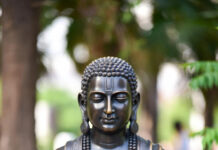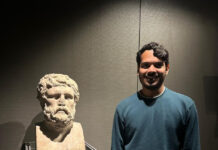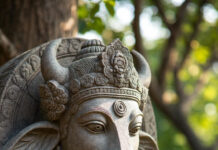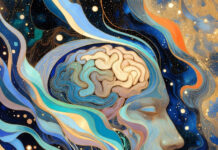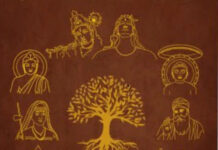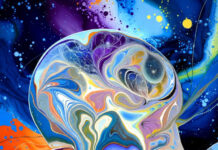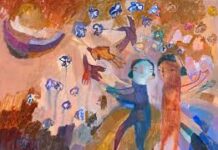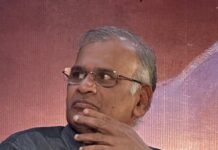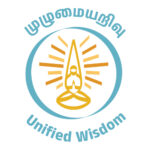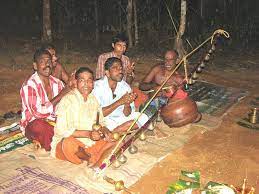
You would have listened to the folklore of Sudalaimadan. As the story goes, when Sudalaimadan travels to the South, he learns the six Shastras (scriptures) and becomes very proficient. In most of the folktales, learning these six Shastras is mentioned rhetorically. In the Villupattu (A folk song, sung with a bow) sessions of the previous generation, the names of the six Shastras are mentioned.
It may be noted that these conversations are not part of a philosophical lecture in a big temple gathering. But it happens in a humble village, sung in praise of a village guardian deity during the offering ceremony. Often the story narrator would have learnt the story aurally. The audience is not a scholarly crowd either.
But information about the six shastras of Hinduism has reached them. In old-time Therukoothu (Tamil folk theatre) and special dramas (Tamil opera), there is a conversation where Murugan comes as an old hunter and marries Valli after a long conversation, testing each other. It is called ‘Velan-Viruthtan Dharkkam’ in the Valli Thirumanam drama (Marriage of Valli). Details about the six shastras are explicitly mentioned there too.
Our illiterate ancestors knew about this. But those of us who believe ourselves as educated would get stumped if asked about the philosophies associated with our religion. We would agree with the words of a non-believer of Hinduism when he/she says that Hinduism is only a set of rigid practices without an underlying philosophy.
Any religion has a curriculum based on its philosophical principles. The Bible is the primary book of Christianity, but there is a curriculum beginning with St. Thomas Aquinas and St. Augustine. Islam has Quran and Hadith. The curriculum of the Buddhist tradition is clearly divided into Sutta Pitaka and Vinaya Pitaka. Sutta Pitaka deals with philosophy and Vinaya Pitaka deals with its practice.
Does Hinduism have such a curriculum? Hinduism is a natural religion. It is not unicentric. There are multiple facets to it. Each facet grows independently while remaining in discussion with each other. There is no general system to control this. So no one can define an overall syllabus
However with the discussions churned within Hindu gnostic traditions, a curriculum has emerged in the process. Just as natural it is that a center can be identified when a circle rotates. It is easily around two thousand years since it’s genesis. In that context, this is one of the ancient religious curriculums.
Vedanta is the common thought across all sects of Hindu religion. Vedanta conversed and debated with all sections of Hinduism. Hence this curriculum is well defined in Vedanta. In the learning traditions of Vedanta, this is taught systematically. In other traditions, it is not necessary that complete traditions are to be studied.
What is that curriculum? It is available as follows. Vedas, Six religions, Six visions (Darshans), Three philosophies, Two epics and Six philosophies. This list completes the curriculum.
Studying the Vedas in their entirety is not common in the philosophical tradition then and now. The Vedas are mostly songs of prayer. They should be recited with their musicality. Each word has been pronounced the same for thousands of years. The method of pronouncing it is called Chandas Shastra.
Such study of the Vedas is only possible for those who make it a full-time education and a full-time life. They do not learn the meaning of the Vedas. They only learn to recite. It is customary in philosophy to study only those passages of scriptures which are quoted in later texts. They don’t need to learn pronunciation. Learning the meaning would suffice
The six religions are Saivam, Vaishnavam, Saktham, Kaumaram, Ganapadhyam and Sowram. They have their respective canon texts which are in the form of legends called Purana stories. There are totally 18 important Puranas belonging to these six religions.
All those 18 Puranas were written in Sanskrit and rewritten in other Indian languages. For example, the legend Skandham was written in Tamil as Kandapuranam by Kachiyappa Sivacharyar. All these six religions have more legends in all languages. For example, Thiruvilayadal Puranam was originally composed in Tamil and revolves around Madurai.
The six visions (Darshans)are Sankya, Yoga, Nyaya, Vaiseshika, Purva Mimamsa and Uttara Mimamsa. These are purely philosophical. With the strong basis of philosophy, these texts of visions talk about the origin of the universe, how it functions, and what it means for human life. The philosophy texts which define them, called as Sutras, are available as crisp one or two liners. (Like Thirukkural)
These are not new principles created by anyone. They have existed since time immemorial. They were later summarised by some authors who claim so. Sankhya – Kapila; Yoga – Patanjali: Vaisheshika – Ganada. Nyaya – Gautama; Purva Meemamsa – Jaimini; Uttara Meemamsa – Badarayana.
The two epics are Ramayana and Mahabharata. The three philosophies are Upanishads, Brahmasutra and Gita. These books are called the three philosophies (Prasthanathraya) because they explain about the three fundamentals – Brahman, Atma, and Mukti.
Thereafter six later philosophies arose. They were created by sages who further elaborated on earlier principles. They are thus. Shankara’s Advaita, Ramanuja’s Visishtadvaita, Madhva’s Dvaita, Nimparkar’s Dvaidatvaita and Vallabha’s Suddhavaita. The sixth philisophy is Saiva Sidhantha. Meikandar and Thirumoolar are two principal teachers of Saiva Sidhantha from the land of the Tamils.
This is the curriculum. Unlike before, everything is available for anyone to read. It is quite possible for anyone who is curious to get an introduction on the subject.
But is it mandatory that all Hindus know this? Not necessarily. But it should be known that there is such a curriculum. The awareness of the composition of the curriculum is important. But to lead a life of plain devotion, it is not necessary to learn these in depth.
Hindu tradition shows two paths towards liberation. Karma and Gnana.
Karma is action. Worship and devotion are included there. Gnana (wisdom) is to know and get free. Theis curriculum is ideal for those who choose the path of Gnana.
Such humongous curriculum is not available in any other religion. A Hindu should deeply study the philosophy scriptures of his chosen sect. It is good to know the other texts and their interpretation briefly. That’s all the possibility available in a lifetime. To assimilate the entire curriculum, only Sudalaimadan stands a chance.
Translated by Geetha Senthilkumar
